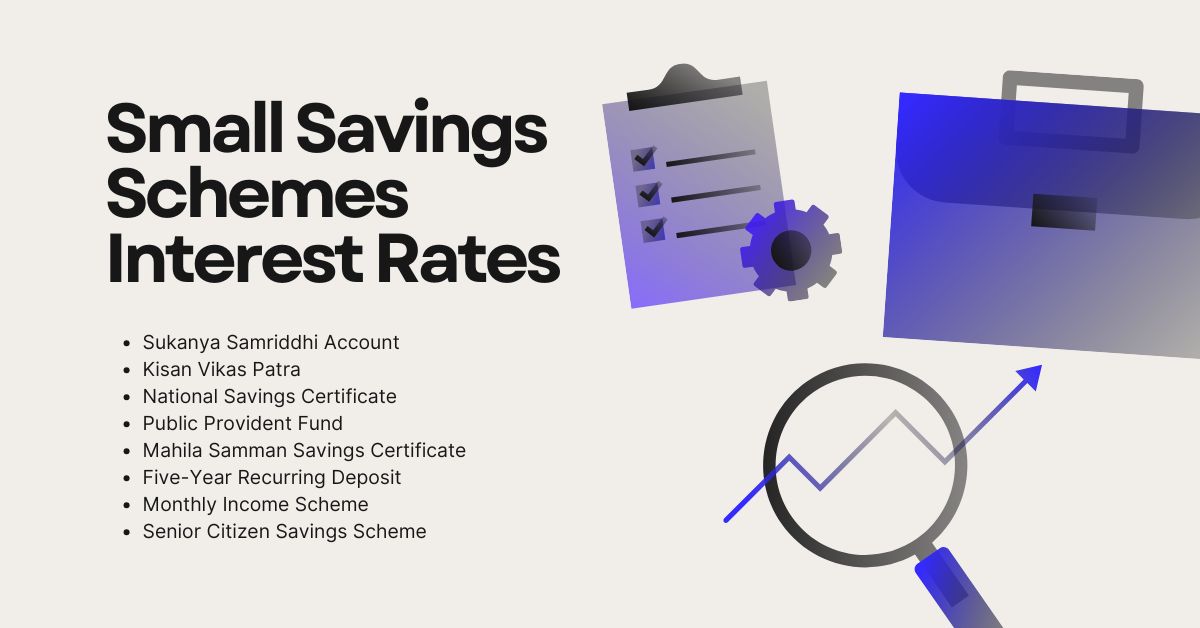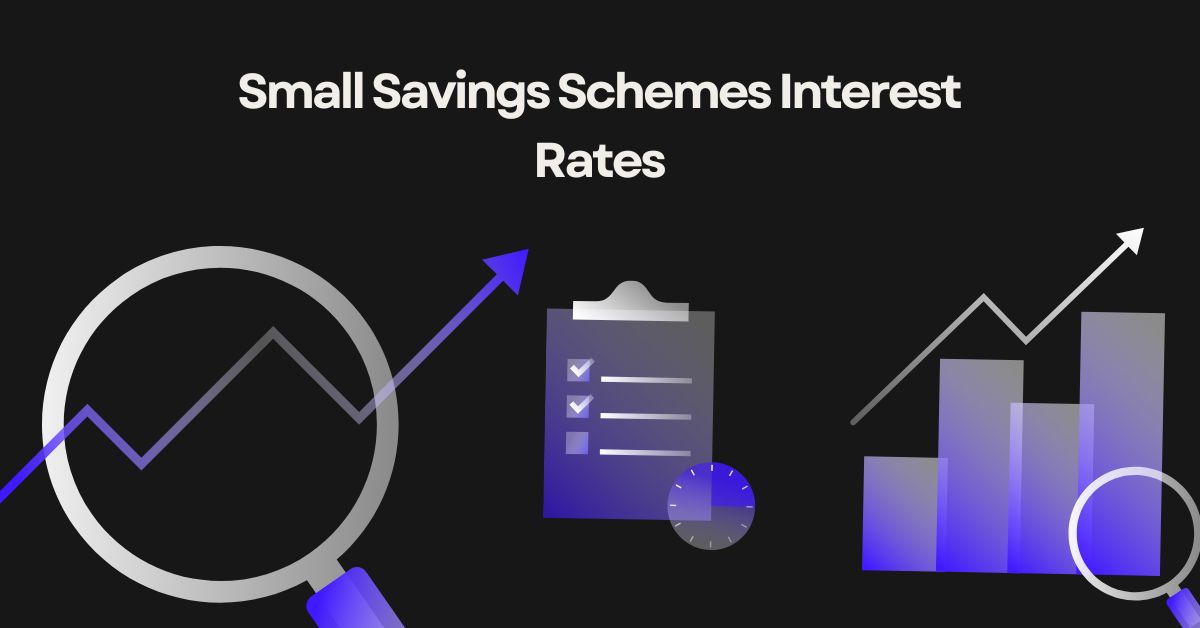Do you want to invest in a safe financial asset for the long term? Aside from fixed deposits (FDs), bonds, and debt mutual funds, one can invest in a post-office modest savings plan. Among these possibilities, one of the most popular modest savings schemes is the public provident fund (PPF).
Small Savings Schemes Interest Rates

Investors that invest in public provident funds may expect to earn 7.1 percent every year. Investments might range from ₹500 to ₹1.5 lakh annually.
Investors are permitted to make one withdrawal each tax year after five years, omitting the year of account establishment. This implies that if an account was started in 2010-11, withdrawals can be made during or after 2016-17. The withdrawal amount can be up to 50% of the credit balance at the end of the fourth preceding year or the end of the preceding year, whichever is lower.
However, one could decide to put money in other small savings plans, such as those listed below:
Sukanya Samriddhi Account
The government-backed Sukanya Samriddhi Yojana (SSY) is a savings plan meant to get parents to save for their daughter’s college and wedding. It has a good interest rate—right now it’s 8.2% per year—and it doesn’t charge any income tax because of Section 80C of the Income Tax Act.
The girl child must live in India and be an Indian native in order to open an SSY account. The parent or legal guardian of the girl child can open the account. A investment of as little as Rs. 250 per year or as much as Rs. 1.5 lakh per year is possible. After 21 years from the date it was opened, the account is no longer active.
The government changes the interest rate on SSY accounts every three months. Even though the rate is 8.2% right now, you should always check the rate before you open an account or put money in it.
Kisan Vikas Patra
The Indian government’s Kisan Vikas Patra (KVP) is a well-known way for people to save small amounts of money. It is a way to spend for the long run that guarantees returns. The interest rate on KVP stays the same for the whole time the investment is held.
Rate of Interest Right Now
The interest rate on KVP is 7.5% per year as of the third quarter of the financial year 2024-25. That is, your investment will grow by two times in about 115 months.
Important things about KVP
- Guaranteed Returns: KVP offers guaranteed returns, which makes it a low-risk way to spend.
- Tax Benefits: The interest earned on KVP is taxable.
- Minimum Investment: The least amount of money you can put into KVP is Rs. 1,000.
- Date of Maturity: KVP has a set date of maturity of 115 months.
- Nominee Facility: You can choose someone to receive the age amount if something bad happens.
Keep in mind that the interest rate on KVP can change from time to time depending on what the government agrees on. To get the most correct and up-to-date information, you should talk to your bank or post office.
National Savings Certificate
People often choose to invest in National Savings Certificates (NSCs), which are part of the Small Savings Schemes that the Indian government offers. They give you a safe way to grow your money and save it. There are many good things about NSCs, such as tax breaks under Section 80C of the Income Tax Act, and the interest you earn is also not taxed.
The interest rate on NSCs is 7.7% per year as of April 1, 2023. This interest rate is compounded once a year, which means that the interest received each year is added to the capital amount for the following year. This makes the returns higher over time.
It is important to know that the Government of India changes the interest rate on NSCs every three months. So, before buying, it’s a beneficial idea to check the most recent interest rate.
The smallest amount you can put in an NSC is Rs. 1,000, and the term is 5 years. After the first payment, you can make more investments in multiples of Rs. 100. You can get NSCs from certain banks and post offices.
Public Provident Fund
The Public Provident Fund (PPF) is a popular long-term investment scheme offered by the Government of India. It’s known for its tax benefits and assured returns. As of October-December 2024, the PPF interest rate is 7.1% per annum. The government sets this rate on a quarterly basis and annually compounds it.
Key features of PPF:
- Tax Benefits: PPF offers triple tax benefits (EEE):
- Exempt: Investments up to Rs. 1.5 lakh per year are tax-deductible under Section 80C of the Income Tax Act.
- Exempt: Interest earned on the PPF account is tax-free.
- Exempt: The maturity amount received is also tax-free.
- Assured Returns: While the interest rate is fixed quarterly, it provides a guaranteed return, making it a relatively safe investment option.
- Lock-in Period: The minimum lock-in period for a PPF account is 15 years.
- Loan Facility: You can take a loan against your PPF balance after the third year.
- Extension: After the initial 15-year period, you can extend the account in blocks of 5 years.
PPF is an excellent option for long-term financial goals like retirement planning, a child’s education, or a significant purchase. It offers a balance of safety, tax benefits, and reasonable returns, making it a popular choice among Indian investors.
Mahila Samman Savings Certificate
The Government of India set up the Mahila Samman Savings Certificate (MSSC) as a way for women to save some money. It has a set interest rate of 7.5% per year, which is added up every three months. The goal of this plan is to get women to save money and invest it.
Key features of MSSC:
- Eligibility: Any woman or guardian of a minor girl can open an account.
- Maximum Deposit: The maximum deposit allowed is Rs. 2 lakh.
- Tenure: The tenure of the scheme is two years.
- Interest Rate: The interest rate is fixed at 7.5% per annum, compounded quarterly.
- Partial Withdrawal: Partial withdrawal is allowed, subject to certain conditions.
- Tax Benefits: Interest earned on the MSSC is taxable.
In conclusion, the Mahila Samman Savings Certificate is a safe and appealing way for women to spend their money. It has a set interest rate and the option to take out some of the money at any time.
If you want to read more financial blogs, you can read here:
- What is Share Market: Understanding the Basics
- What is CAGR? Understanding the Compound Annual Growth Rate
Five-Year Recurring Deposit
In India, a 5-Year Recurring Deposit (RD) is a popular way to spend because it is a safe way to save money regularly and make interest. With a 5-year RD, you put a set amount of money into your account every month. At the end of the term, you get back the full amount you put in plus interest that has been added.
At the moment, different banks and banking institutions offer different interest rates on 5-year RDs. But in general, they are between 6.5% and 7.5% per year. It’s important to remember that interest rates can change depending on the bank’s (RBI) monetary strategy and the state of the market.
Check with the bank or financial company of your choice to get the most exact and up-to-date information on interest rates for 5-year RDs. You can also look at the interest rates that different banks offer to find the best deal for your needs.
Monthly Income Scheme
Banks, post offices, and other financial institutions offer the Monthly Income Scheme (MIS), which is a popular way to invest. It is especially made to give owners a steady monthly income.
Here’s a breakdown of the scheme:
Key Features:
- Regular Income: The primary benefit of MIS is the consistent monthly income it generates.
- Fixed Tenure: Typically, the tenure of an MIS is 5 years.
- Minimum Investment: The minimum investment amount varies across institutions, but it’s generally a few thousand rupees.
- Maximum Investment: The maximum investment limit also varies, but it’s usually capped at a certain amount.
- Tax Implications: The interest earned from MIS is taxable as per the individual’s income tax slab.
Interest Rates:
The interest rates for MIS can vary depending on the financial institution and the prevailing market conditions. As of now, the interest rate for the Post Office Monthly Income Scheme is 7.4% per annum, payable monthly.
Senior Citizen Savings Scheme
The Senior Citizen Savings Scheme (SCSS) is an Indian government-backed savings plan for people over the age of 60. With a set interest rate, it’s a safe and appealing way to spend.
The interest rate for SCSS is 8.2% per year as of the third quarter of the financial year 2024-25. It is important to remember that the interest rate is looked at every three months, and the government may change it from time to time.
SCSS offers several benefits:
- High Interest Rate: The current interest rate of 8.2% is one of the highest among fixed-income small savings schemes.
- Tax Benefits: While the interest earned is taxable, the initial investment of up to Rs. 1.5 lakh per year is eligible for tax deductions under Section 80C of the Income Tax Act.
- Safety and Security: Being a government-backed scheme, SCSS offers a high level of security and is considered a low-risk investment.
- Flexible Tenure: The scheme has a tenure of 5 years, with an option to extend it for another 3 years.
To be able to join SCSS, you must be an Indian national and at least 60 years old. The most that can be invested is 30 lakh rupees. You can start a SCSS account at certain banks and post offices.

